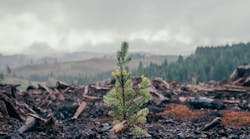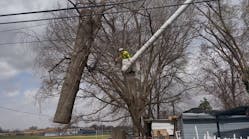We’ve all seen the devastation wildfires can cause. Buildings and homes are often decimated; evacuation routes are flooded with families in cars; and countless acres of land are ravaged in a matter of hours or days. Avoiding these unfortunate results can be challenging, but utility vegetation management programs can play an integral role in minimizing their occurrences and severity.
According to the California Department of Forestry and Fire Prevention, one in every 10 wildfires are caused by electrical power. Statistically speaking, that means electrical power was responsible for nearly 6,000 of the 58,968 wildfires reported by the Congressional Research Service in 2021.
From dry conditions and high temperatures to rough terrain and varying densities of incompatible plant species, vegetation managers face numerous challenges as they work to prevent trees and other woody plants from causing wildfires and lapses in electrical service. Fortunately, utility vegetation managers can use the following strategies to prevent trees and other incompatible plant species from impacting utility infrastructure, which significantly enhances electrical transmission reliability and wildfire mitigation efforts as well as a utility’s public image.
1. Conduct Regular Inspections
Optimizing resource management is essential for vegetation management programs as they are often expected to do more with less. By regularly inspecting managed land for areas where problematic trees and other incompatible plants pose the greatest threat to utility infrastructure, vegetation managers can effectively prioritize the control and removal of vegetation that either poses a wildfire risk or threat to electrical transmission reliability.
In addition to inspecting vegetation throughout and adjacent to utility right-of-way (ROW) corridors, the following inspections can help prevent utility pole failures and wildfire ignitions caused by inadvertent sparks:
- Check guy wire poles for wood decay or deterioration
- Ensure security of guy wires and anchoring systems
- Confirm bareground results around the base of each pole
Environmental research studies have shown that the exclusive use of mechanical control methods, such as mechanized mowing, is generally ineffective at providing long-term control of incompatible trees and other problematic plant species throughout the wire zone and border zone of utility ROW.
Mechanical control strategies can be used to remove undesirable vegetation. However, incompatible trees and a variety of highly flammable plant species will continue to spread and resprout as long as their roots remain intact, which only creates additional maintenance requirements over time. That’s why vegetation managers are encouraged to use the following herbicide applications to complement mowing practices and effectively control targeted vegetation:
- Basal bark, basal cut-stump or dormant-stem treatments
- Grass-friendly brush mixes
- Hack-and-squirt treatment
- Cut-stubble treatment
3. Remove Remaining Debris
Mechanical control methods can provide short-term relief to safeguard the integrity of utility infrastructure, and herbicide treatments can help prevent the reestablishment of incompatible vegetation in the future. However, any debris that remains after these treatments can still provide ample fuel for a wildfire. Utility foresters and vegetation managers can use the following strategies to ensure these fire hazards are effectively removed or repurposed:
- Bale woody biomass for proper off-site disposal
- Cut trees into lengths that can be sold to local mills
- Use chippers to break down debris and broadcast to sloped areas for erosion control
4. Prioritize Communication
Public and private land often runs adjacent to utility ROW, making the use of effective vegetation control strategies on those sites equally important. While utility vegetation managers can collaborate with a variety of public and private entities to improve fuel load reduction and tree removal strategies in these areas, ensuring landowners and other land entities approve of each applied strategy is essential.
That’s why Corteva Agriscience developed Notify Your Neighbor, a resource guide that contains valuable tools to help vegetation managers prepare for effective conversations with concerned members of the public. In addition to strategies, techniques and key messages that can help increase compliance, reduce complaints and improve productivity, the resource also contains instructional videos and informative brochures that vegetation managers can engage with to refine public communications on their own time. To request access to Notify Your Neighbor, contact your local Corteva Vegetation Management Specialist.
Vegetation managers are often the unsung heroes for utility companies, and their impact reaches far beyond the edges of utility ROW. Their work can not only enhance electrical transmission reliability and wildfire mitigation efforts, but also a utility company’s public image. Effective vegetation control strategies can be used to ensure these positive outcomes; it’s simply a matter of applying them in the right place at the right time. To learn more about best practices for managing incompatible vegetation throughout utility ROW and adjacent lands, visit utility.VegetationMgmt.com.





